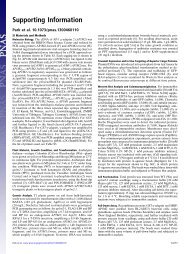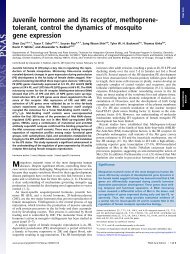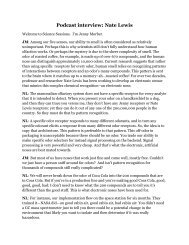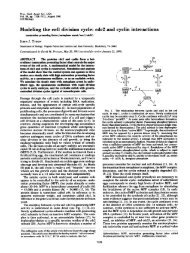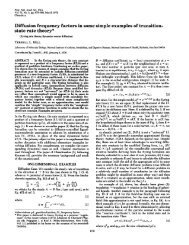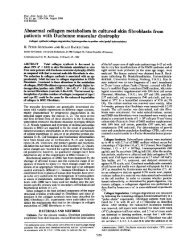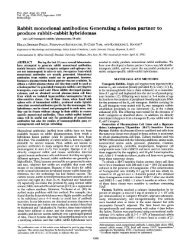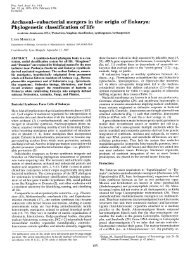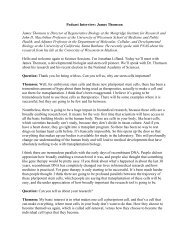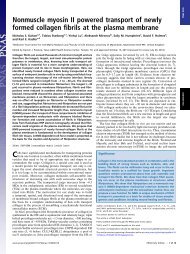SUMO-1 - Proceedings of the National Academy of Sciences
SUMO-1 - Proceedings of the National Academy of Sciences
SUMO-1 - Proceedings of the National Academy of Sciences
Create successful ePaper yourself
Turn your PDF publications into a flip-book with our unique Google optimized e-Paper software.
elements were used to examine whe<strong>the</strong>r substitutions in <strong>the</strong><br />
<strong>SUMO</strong>-1 attachment sites <strong>of</strong> AR influence <strong>the</strong> transcriptional<br />
activity <strong>of</strong> <strong>the</strong> receptor. The K520R mutant that is modified by<br />
<strong>SUMO</strong>-1 almost as well as wt AR had transcriptional activity in<br />
COS-1 cells indistinguishable from that <strong>of</strong> wt AR (Fig. 4A). In<br />
contrast, K386R and K386R�K520R mutants, which were poor<br />
targets for <strong>SUMO</strong>-1 conjugation, had activities 1.9- and 2.4-fold<br />
higher than that <strong>of</strong> wt AR, respectively. More importantly, <strong>the</strong><br />
compound mutant was constantly 2.4- to 3.3-fold more active<br />
than <strong>the</strong> wt receptor over a wide range <strong>of</strong> expression plasmid<br />
amounts (1–100 ng�well) and testosterone concentrations (0.1–<br />
100 nM) (Fig. 4B and data not shown). The higher transcriptional<br />
activity <strong>of</strong> K386R�K520R mutant cannot be explained by<br />
receptor protein levels because, if anything, <strong>the</strong> expression level<br />
<strong>of</strong> <strong>the</strong> double mutant was lower than that <strong>of</strong> wt AR as assessed<br />
by immunoblotting (Fig. 4B Inset). In addition to COS-1 cells,<br />
K386R and K386R�K520R mutants were 2- and 2.4-fold more<br />
active than wt AR in HeLa cells (data not shown).<br />
We have previously shown that overexpression <strong>of</strong> Ubc9 can<br />
result in enhancement <strong>of</strong> AR-mediated transcription. As shown<br />
in Fig. 4C, ligand-dependent activity <strong>of</strong> wt AR was clearly<br />
enhanced (3.2-fold) when 100 ng�well <strong>of</strong> Ubc9 was coexpressed,<br />
whereas <strong>the</strong> compound mutant showed practically no response<br />
to Ubc9 (1.2-fold). However, K386R�K520R mutant was stimulated<br />
by a higher Ubc9 dose (300 ng�well), even though <strong>the</strong><br />
induction (1.9-fold) was clearly lower than that with wt receptor<br />
(5.1-fold). Thus, effects <strong>of</strong> Ubc9 overexpression on ARdependent<br />
transcription are complex and not merely a direct<br />
consequence <strong>of</strong> enhanced sumoylation <strong>of</strong> AR. This is in line with<br />
<strong>the</strong> finding that sumoylation-negative Ubc9 mutant can also<br />
stimulate AR-dependent transactivation (9). Overexpression <strong>of</strong><br />
Ubc9 may, in fact, stall <strong>the</strong> sumoylation machinery because o<strong>the</strong>r<br />
components <strong>of</strong> <strong>the</strong> conjugation system are likely to become<br />
limiting. This should lead to enhancement ra<strong>the</strong>r than inhibition<br />
<strong>of</strong> AR-dependent transcription.<br />
In contrast to transcriptional activation, <strong>the</strong> transrepressing<br />
function <strong>of</strong> AR was not influenced by substitution <strong>of</strong> <strong>SUMO</strong>-1<br />
acceptor sites, because both wt AR and <strong>the</strong> K386R�K520R<br />
mutant repressed a NF-�B�RelA-activated promoter to <strong>the</strong><br />
same extent (Fig. 5A). Fur<strong>the</strong>rmore, <strong>the</strong> effects <strong>of</strong> <strong>the</strong> point<br />
mutations on ligand binding and DNA binding by AR were<br />
investigated in intact cells. Consistent with <strong>the</strong> lower expression<br />
level <strong>of</strong> <strong>the</strong> compound mutant, cells transfected with <strong>the</strong> mutant<br />
construct showed �30% less androgen-binding sites than cells<br />
transfected wt AR, as assessed by whole cell-binding assays (data<br />
not shown). DNA-binding capacity <strong>of</strong> compound mutant, as<br />
examined by promoter interference assays using <strong>the</strong> same double<br />
hormone response elements as in ARE2TATA-LUC, was somewhat<br />
lower (10–20%) than that <strong>of</strong> wt AR (30) (Fig. 5B), which<br />
is in line with androgen-binding data.<br />
Discussion<br />
In <strong>the</strong> present study, we have shown that a ligand-activated<br />
transcription factor, AR, is covalently modified by <strong>SUMO</strong>-1 in<br />
intact cells and under cell-free conditions. Androgen promoted<br />
sumoylation in cells, probably by facilitating <strong>the</strong> nuclear transfer<br />
<strong>of</strong> cytoplasmic AR. The sumoylation sites <strong>of</strong> human AR are<br />
K386 and K520. The former appears to act as a master switch <strong>of</strong><br />
sumoylation, because <strong>the</strong> K386 mutant was modified only poorly,<br />
whereas <strong>the</strong> K520 mutation impaired <strong>the</strong> extent <strong>of</strong> <strong>SUMO</strong>-1<br />
conjugation much less. The overall cellular distribution <strong>of</strong> <strong>the</strong><br />
K386R�K520R mutant and its hormone-induced nuclear translocation<br />
were very similar to those <strong>of</strong> <strong>the</strong> wt AR (data not<br />
shown). Both sumoylation sites are fully conserved in mammalian<br />
AR sequences, and a site corresponding to human K386 is<br />
also present in <strong>the</strong> Xenopus AR.<br />
In addition to AR, several o<strong>the</strong>r, but not all, members <strong>of</strong> <strong>the</strong><br />
steroid receptor family contain potential (I�L�V)KXE attachment<br />
Fig. 5. Effect <strong>of</strong> K386R�K520R mutation on transrepressing activity <strong>of</strong> AR<br />
and DNA binding in intact cells. (A) Repression <strong>of</strong> RelA-dependent transactivation<br />
by wt AR and K386R�K520R mutant. COS-1 cells were transfected with<br />
p�B6tk-LUC (150 ng), pCMV-RelA (30 ng), and AR expression vectors (150 ng).<br />
The relative LUC activity in <strong>the</strong> absence <strong>of</strong> cotransfected AR is set as 100. Values<br />
are means � SD from six independent experiments. (B) Binding <strong>of</strong> <strong>the</strong> wt and<br />
mutant AR to androgen response elements in intact cells as determined by a<br />
promoter interference assay (30). COS-1 cells were transfected with pCMV-<br />
ARE2-LUC reporter (100 ng) and increasing amounts (10, 50, and 100 ng) <strong>of</strong> wt<br />
Flag-AR and K386R�K520R mutant expression vectors. The total amount <strong>of</strong><br />
DNA was kept constant by adding empty pcDNA3.1(�) when necessary.<br />
Reporter gene activity in <strong>the</strong> absence <strong>of</strong> AR expression vector is set as 100, and<br />
<strong>the</strong> means � SD from three independent experiments are shown. Black and<br />
gray bars depict wt AR and K386R�K520R mutant, respectively.<br />
sites for <strong>SUMO</strong>-1 (Table 1). In this study, we show that GR is<br />
modified by <strong>SUMO</strong>-1 in vitro under <strong>the</strong> same Ubc9-dependent<br />
conditions as those used for AR. Intriguingly, <strong>the</strong> sumoylated sites<br />
in AR and <strong>the</strong> two potential modification sites in <strong>the</strong> N-terminal<br />
domain <strong>of</strong> GR are identical with <strong>the</strong> protein motifs that have<br />
recently been demonstrated to restrict <strong>the</strong> transcriptional synergy <strong>of</strong><br />
<strong>the</strong> two receptors (29). In line with our data on AR, disruption <strong>of</strong><br />
<strong>the</strong>se sites by replacing <strong>the</strong> central <strong>SUMO</strong>-1 acceptor Lys with Arg<br />
led to enhancement <strong>of</strong> AR-dependent transcription on promoters<br />
with more than one hormone response elements (29). The synergy<br />
control motifs are identical with <strong>the</strong> sumoylation consensus sequence,<br />
and <strong>the</strong>y can be found in negative regulatory regions <strong>of</strong><br />
many, o<strong>the</strong>rwise unrelated, transcription factors (29), suggesting<br />
that sumoylation can act as a general mechanism controlling <strong>the</strong>ir<br />
activities.<br />
In contrast to AR, sumoylation <strong>of</strong> p53 has recently been<br />
implicated in <strong>the</strong> activation <strong>of</strong> p53-dependent transcription (27,<br />
28). However, similar to AR, <strong>the</strong> basal transcriptional activity <strong>of</strong><br />
<strong>the</strong> sumoylation-defective p53 mutant was ei<strong>the</strong>r equal to or<br />
higher than that <strong>of</strong> wt p53, depending on <strong>the</strong> promoter studied.<br />
In <strong>the</strong> case <strong>of</strong> AR, <strong>the</strong> extent to which <strong>SUMO</strong>-1 acceptor sites<br />
were mutated correlated with increased transcriptional activity,<br />
indicating that sumoylation can, in fact, attenuate AR function.<br />
This is in agreement with a recent report showing that c-Jun is<br />
negatively regulated by sumoylation (42). The result that <strong>the</strong><br />
K386R�K520R mutant was coactivated by GR-interacting protein<br />
1 (GRIP1) in a fashion similar to wt AR (data not shown)<br />
is in keeping with <strong>the</strong> fact that <strong>the</strong> sumoylation sites do not<br />
overlap with <strong>the</strong> core transactivation domain <strong>of</strong> AR (43). The<br />
sumoylation sites localize to <strong>the</strong> N-terminal region <strong>of</strong> AR that is<br />
involved in interactions with <strong>the</strong> hormone-bound ligand-binding<br />
domain, and <strong>the</strong>refore, attachment <strong>of</strong> bulky ‘‘side chains’’ to this<br />
region is likely to perturb with <strong>the</strong> ability <strong>of</strong> AR to make<br />
intramolecular contacts (33). NF-�B-transrepressing activity <strong>of</strong><br />
AR (44) is not influenced by point mutations substituting <strong>the</strong><br />
Poukka et al. PNAS � December 19, 2000 � vol. 97 � no. 26 � 14149<br />
BIOCHEMISTRY



